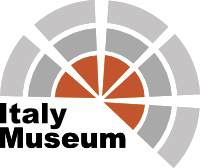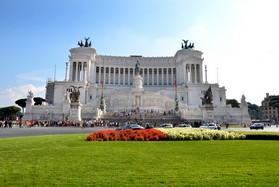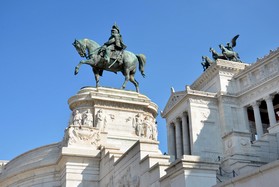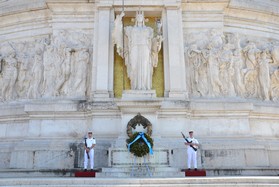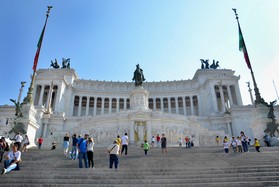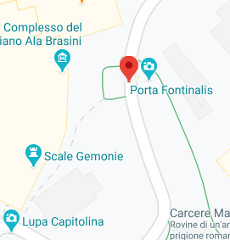Victorian Complex
A bit of history of the Victorian Complex
After the birth of Italy in 1860, something was sought to represent national unity under the leadership of the new King. So, it was decided to build a grand monument that was later called the Vittoriano Complex, in honour of Vittorio Emanuele II, the first King of Italy, whose equestrian statue stands out right in the centre. At the foot of it, stands the Altar of the Fatherland (name sometimes referred to as the Vittoriano) together with the tomb of the Unknown Soldier.
The complex is one of the most important symbols of Rome and every year is visited by thousands of tourists, also fascinated by its bright colour, due to the Botticino marble, and its size. The monument consists of an imposing staircase, which follows the shape of the Capitol, one of the seven hills on which Rome was founded and what has always been a representative place of Roman power. The idea of the initial project was to create a symbol of the power of Rome Capital, next to those of Papal Rome (the Vatican) and Imperial Rome (the Colosseum).
Over the years, the monument has had an alternating fortune: used as a patriotic emblem during Fascism and used by the dictatorship as a privileged place for public speeches, precisely because of this role has been forgotten for a long time, until today's revaluation as a space of secular representation of love for the homeland and as a place of memory and culture, thanks also to the museums and exhibition halls at the base of the complex.
What is the Victorian Complex today?
Born as a symbolic and festive place, today the Vittoriano Complex is also one of the largest exhibition spaces in Rome. Inside, is the Central Museum of the Risorgimento, dedicated to the history of Italy from the late 18th century to World War I, and the Monument to the Flags. Also, adjacent to these two, there are some rooms used for temporary exhibitions.
These exhibitions, always varied and interesting, are dedicated to some of the most influential artists of the cultural scene of all times, such as Botero, Monet, Antonio Ligabue, Andy Warhol, Pollock and many others. Today the monumental complex is also the scene of the most important Italian celebrations, such as the Day of the Italian Republic (June 2) and the Independence Day (April 25).
Curiosity about the Victorian Complex?
Did you know that in the Victorian Complex is the body of the Unknown Soldier? At the end of World War I, a young soldier was found dead, whose body was so full of wounds that it was unrecognizable. Precisely for this reason, it was decided to bury him right where the Altar of the Fatherland now stands, so that his sacrifice could be recognized and honoured.
Since no one ever knew the name of this boy, his body became the symbol of all the soldiers who died for the homeland. The tomb is guarded by an always burning flame and by two guards, who are soldiers from all the Italian armed forces, who alternate the guard every ten years.
Why visit the Vittoriano Complex?
The Vittoriano is not only one of the most important monuments of the Capital, but it is also a privileged place to know a part of Italian history. If you want to discover how the Beautiful Country was born and what were the events that led to its establishment, this is the place where you can find the answers. If, on the other hand, you are passionate about modern and contemporary art, you will undoubtedly find an exhibition to your taste here.
Also, If you happen to be in Rome on one of the important dates for the history of the Italian Republic, you can attend the official celebrations. These celebrations often take place here and are also accompanied by the splendid Frecce Tricolori, the military planes that, on extraordinary occasions, dart through the sky leaving long trails with the colours of the Italian flag.
How can I visit the Vittoriano Complex
To visit the exhibitions inside the Vittoriano Complex, you can buy the entrance ticket for each of them in combination with the Audio Guide of the city of Rome so you can visit the "Eternal City" on your own.
Other attractions in the area
The centre of Rome is full of monuments, buildings, museums and archaeological sites that you will surely want to visit. Near the Vittoriano Complex, you can admire the Roman Forum, which for many centuries has been the centre of the political, economic, religious and legal life of the Roman civilization.
Not far away is the imposing Colosseum; considered the largest amphitheater in the world, this was a space used for gladiatorial shows and other events and could hold up to almost one hundred thousand people.
In case you want to immerse yourself in religious Rome, you cannot miss a visit to the Vatican State, with the magnificent St. Peter's Basilica and the wonderful art of the Vatican Museums and the Sistine Chapel.
Finally, if art is your main interest, you can visit the beautiful Villa Borghese and its Art Gallery, which houses some works by Caravaggio, Raphael, Titian and Rubens, among others. In the museum, you can also admire the Paolina Borghese as the Venus Victorious, famous work by Canova.
You may be interested in:
Useful Information
Open Monday to Thursday from 9:30 am to 7:30 pm, Friday to Saturday from 9:30 am to 10:00 pm and Sunday from 9.00 am - 8.30 pm.
Discover the most suggestive museums of Rome:

+39 055713655
Reach the museums in total comfort with our transfer service!

TRANSFER SERVICE
book now
